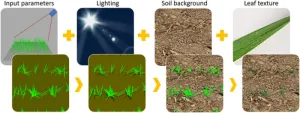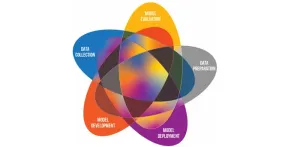(Press-News.org)
In cereal crops, the number of new leaves each plant produces is used to study the periodic events that constitute the biological life cycle of the crop. The conventional method of determining leaf numbers involves manual counting, which is slow, labor-intensive, and usually associated with large uncertainties because of the small sample sizes involved. It is thus difficult to get accurate estimates of some traits by manually counting leaves.
Conventional methods have, however, been improved upon with technology. Deep learning has enabled the use of object detection and segmentation algorithms to estimate the number of plants (and leaves on these plants) in an area. There is, however, a roadblock to using these algorithms. They count leaf tips, which appear tiny in images, proving difficult to detect. Consequently, deep learning methods often fail to perform in actual field conditions. Aiming to solve this problem, a multinational research team developed a self-supervised leaf-tip counting method based on deep learning techniques, which yielded wheat leaf count with high accuracy. The study was led by Professor Shouyang Liu of the Nanjing Agricultural University and was published online in Plant Phenomics on March 20, 2023.
Speaking about their work, Prof. Liu says, “We developed a high-throughput method to count the number of leaves on wheat plants by detecting leaf tips in RGB (red-green-blue) images. The Digital Plant Phenotyping platform (D3P) was used to simulate a large, diverse dataset of RGB images and corresponding leaf-tip labels of wheat plant seedlings. Over 150,000 images were generated, with over 2 million labels.”
The researchers used domain adaptation—in which a neural network trained on a “source” dataset is applied to a “test” dataset, also referred to as a “target” dataset. This was achieved through deep learning techniques that mimic neural processes used by the human brain and use algorithms inspired by its structure and function.
Next, the researchers collected 2,763 RGB images of juvenile wheat fields from 11 locations spread across five countries. A variety of measures were used to create a robust and reliable source dataset—different types of cameras, varying imaging angles, and images with diverse soil backgrounds/light conditions were used. Besides capturing field images, the team also generated simulated wheat images, which were automatically annotated using the D3P. Domain adaptation was used to improve the realism of these images, which were then used to train the deep learning models.
Six combinations of deep learning models and domain adaptation techniques were used in this study; the Faster-RCNN model with CycleGAN adaptation technique demonstrated the best performance. This was evident from its high coefficient of determination (R2 = 0.94)—a measure that determines the goodness of fit of a model—and optimal root mean square error (RMSE = 8.7)—a standard way to measure the error of a model in predicting quantitative data.
Moreover, of the three factors evaluated for performance of the leaf counting models, light condition was found to be of utmost importance. On the other hand, leaf texture and soil brightness were found to be less important for performance, but the combination of all the three factors was found to significantly improve the realism of the images. The results also revealed that a spatial resolution higher than 0.6 mm per pixel was required to ensure accurate identification of leaf tips.
Explaining the implications of their study, Prof. Liu says, “The resulting proposed deep learning method appears very attractive since it eliminates the tedious, expensive, and sometimes inaccurate manual labeling task by simulating images for which the labels are automatically generated. The images were also made more realistic using domain adaptation techniques.”
The research team has made the trained networks available at https://github.com/YinglunLi/Wheat-leaf-tip-detection to facilitate further research in this area. Kudos to the team for their noteworthy contribution!
###
Reference
Authors
Yinglun Li1, Xiaohai Zhan1, Shouyang Liu1, Hao Lu2, Ruibo Jiang1, Wei Guo3, Scott Chapman4, Yufeng Ge5, Benoit de Solan6,7, Yanfeng Ding1, Fred Baret1, 6
Affiliations
1Plant Phenomics Research Centre, Nanjing Agricultural University.
2Key Laboratory of Image Processing and Intelligent Control, Huazhong University of Science and Technology.
3Graduate School of Agricultural and Life Sciences, The University of Tokyo.
4School of Agriculture and Food Sciences, The University of Queensland.
5Department of Biological Systems Engineering, University of Nebraska-Lincoln.
6INRAE, Avignon Université.
7ARVALIS Institut du végétal, France.
END
As temperatures across the globe reach record-level highs, urban areas are facing increased heat stress. Cities are generally warmer and dryer than adjacent rural land. But in the Global South, there is an additional complicating factor — urban humid heat.
A new study, led by Yale School of the Environment scientists and published in Nature, investigated the combined effect of temperature and humidity on urban heat stress using observational data and an urban climate model calculation. Researchers found that the heat stress burden is dependent on local climate and a humidifying effect can erase the cooling benefits that would come from trees and vegetation.
“A widely ...
Artificial intelligence and machine learning (AI/ML) technologies are constantly finding new applications across several disciplines. Medicine is no exception, with AI/ML being used for the diagnosis, prognosis, risk assessment, and treatment response assessment of various diseases. In particular, AI/ML models are finding increasing applications in the analysis of medical images. This includes X-ray, computed tomography, and magnetic resonance images. A key requirement for the successful implementation of AI/ML models in ...
As additive manufacturing becomes more commonplace, researchers are exploring new methods to ensure that products are as strong and more sustainable than their traditionally manufactured analogues. At the University of Pittsburgh, engineers have set their sights on using multiple lights and neural networks to improve the finishing process of this complex process.
Xiayun Zhao, assistant professor of mechanical engineering and materials science at Pitt’s Swanson School of Engineering, received a Faculty Early Career Development (CAREER) award from the National Science Foundation (NSF) for her research in photopolymer additive manufacturing (PAM). ...
Revelations and research over the last few years have shed light on how Instagram may negatively affect its youngest users. The most popular social media platform among 13- to 21-year-olds in America, Instagram was designed to connect people with shared interests. However, recent research has pointed to the use of social media as possibly contributing to a rise in mental health and eating disorders among teenage girls. Researchers at Drexel University and Vanderbilt University are trying to figure out exactly what young users are experiencing on Instagram, in hopes of curtailing the negative trend and getting them the support they need.
In ...
CORVALLIS, Ore. – Darius Adams, professor emeritus in the Oregon State University College of Forestry, is one of three researchers sharing this year’s international Marcus Wallenberg Prize for developing a pair of groundbreaking forest economic models.
The annual prize, one of the highest honors in the field of forestry, was announced last week in Sweden and is named for the late Marcus Wallenberg Jr., a banker, industrialist and member of Sweden’s long-influential Wallenberg family.
Adams is the second Wallenberg awardee from the College of Forestry in the last three years. In 2020 another OSU professor emeritus, Richard ...
It’s tempting to argue with someone who is misinformed by showing them studies and articles that prove they’re wrong. But new research shows that there’s another, less confrontational, way to get someone to change their mind.
A new study in Scientific Reports, led by Dolores Albarracín, a social psychologist who specializes in attitudes and persuasion, and the Alexandra Heyman Nash Penn Integrates Knowledge University Professor at the University of Pennsylvania, has found that “bypassing” misinformation is just as effective as debunking it head-on.
This ...
New York (April 26, 2023) — Today, the American Geriatrics Society (AGS) announced that it will be honoring Alan Lazaroff, MD, AGSF with its David H. Solomon Memorial Public Service Award, for his passionate advocacy to better align Medicare payment to meet the unique healthcare needs of older adults and to improve care coordination for patients with chronic conditions.
“Dr. Lazaroff has been involved with the work of the American Geriatrics Society for over 25 years,” said AGS President G. Michael Harper, MD, AGSF. “When the AMA/Specialty Society Relative Value ...
Obesity is a growing epidemic in children and adults. A large national study published in the International Journal of Obesity now finds that preteens carrying excess weight have notable differences in cognitive performance, brain structures, and brain circuitry when compared to preteens with normal body-mass index (BMI).
Funded by the National Science Foundation’s Harnessing the Data Revolution initiative, the study involved nearly 5,000 9- to 10-year-olds at 21 sites across the United States. While it only examines the relationship between BMI and the brain and cannot establish causation, there is a significant association between ...
A new analysis suggests that, during the COVID-19 pandemic, US dog and cat owners became closer to their pets, and a complex relationship unfolded between pet ownership, stress, and loneliness. Niwako Ogata and Hsin-Yi Weng of Purdue University, US, and their colleague present these findings in the open-access journal PLOS ONE on April 26, 2023.
The COVID-19 pandemic provides a unique setting to explore pet-owner relationships and potential links between pet ownership and mental health. Several prior studies have investigated these topics in the context of the ...
The earliest inhabitants of Puerto Rico might have used common burial sites and mortuary practices across many centuries, according to a study published April 26, 2023, in the open-access journal PLOS ONE by William J. Pestle of the University of Miami, Florida and colleagues.
Puerto Rico was inhabited by people for several thousand years prior to the Ceramic Age, but little is known about these earliest inhabitants due to a paucity of evidence and research, with only 20 ancient individuals reported from this time period. In this study, Pestle and colleagues describe five adult individuals from burials at the ...






